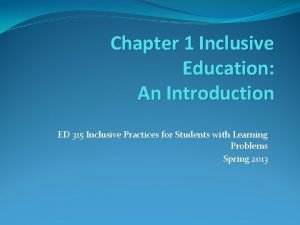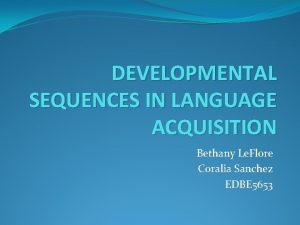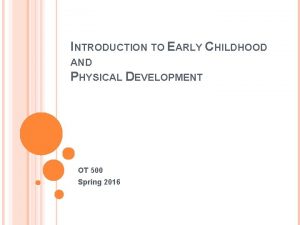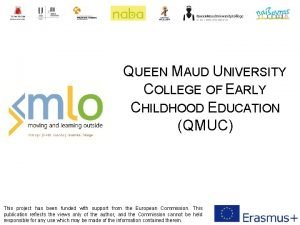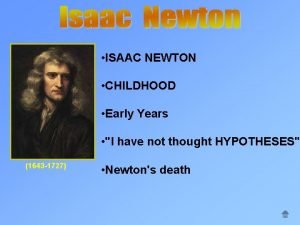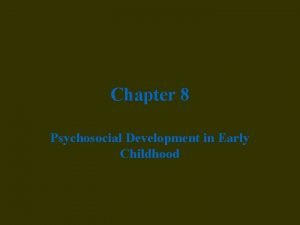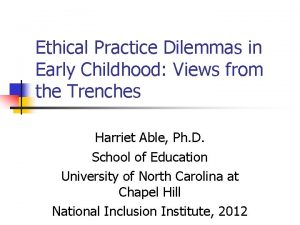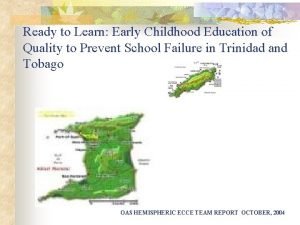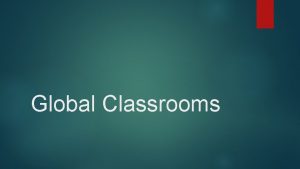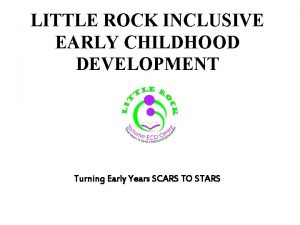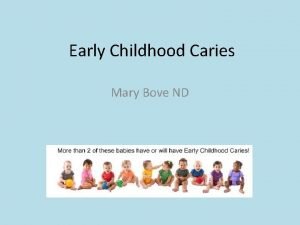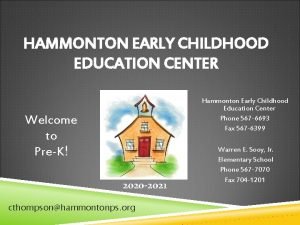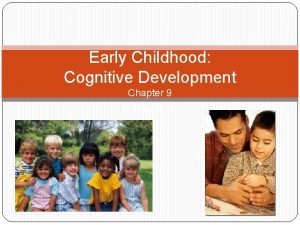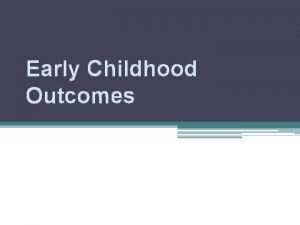The Chastity of Inclusive Classrooms in Early Childhood












- Slides: 12

The Chastity of Inclusive Classrooms in Early Childhood Education Presented by Sehin Yared May 31, 2012

What is an Inclusive Classroom? l l Based on joint statement of DEC and NAEYC Inclusive classroom embodies the values, policies, and practices that support – – – 2 The right of every infant and his or her family Regardless of ability to participate in broad range of activities and contexts As full members of families, communities, and society Sehin Yared

What is the purpose of Inclusion? l Desired results of inclusive experiences for the children include – – – 3 Provide a sense of belongingness and membership to the family and the children with or without disabilities Provide positive social relationships and friendships Development and learning to reach their full potential Sehin Yared

What are the defining features? l l Major beneficiaries include “children with exceptionalities or special needs” High quality early childhood inclusive classrooms are identified by their services to provide – – – 4 Access Participation Support Sehin Yared

What is our recent history with special need children? l l 5 Just as an unfavorable as minorities that include women and people of color At the minimum, the society did not provide access and support special need children Children with special need were isolated to their own and their families No establishments that include the government provide support to this vulnerable population Sehin Yared

Individuals with Disability Act (IDEA) – “backer of inclusion” l With fierce and persistent struggle of families, concerned citizens and self-advocacy – – – 6 Justified the need for the federal government in providing support for disable children The new IDEA law was enacted in 1975 The law provide access of special education to all children with disabilities Protects the rights of the children and their families Assists local governments for the children education Sehin Yared

What do opponents say about the law and the idea of inclusion? l Straight forward arguments against inclusion include high cost and adverse effect on the other children – – 7 Adverse effect to the other children (“inclusion has neglected to truly evaluate how inclusion affects the general, non-disabled student” (Antoinette 2059). The high cost “to specially train teachers and develop facilities in public schools to allow for full inclusion…” (Fardell). Sehin Yared

What are the counter arguments from the proponents of inclusion? l l l 8 The positive effect of teaching the other children acceptance and diversity out weighs the negative For a country so rich and blessed, nothing, especially no cost should justify to discriminate and neglect its needy children Additional support is provided in the field work done by interviewing parent of special need child and inclusive classroom teacher Sehin Yared

References: l l 9 Antoinette, Marissa L. "Examining How the Inclusion of Disabled Students Into the General Classroom May Affect Non. Disabled Classmates. " Fordham Urban Law Journal 7 th ser. 30. 6 (2002): 2039+. The Berkeley Electronic Press (bepress). Web. 20 May 2012. <http: //ir. lawnet. fordham. edu/cgi/viewcontent. cgi? article=2217& context=ulj>. "Archived: 25 Year History of the IDEA. " Archived: 25 Year History of the IDEA. US Department of Education. Web. 23 May 2012. <http: //www 2. ed. gov/policy/speced/leg/idea/history. html>. Sehin Yared

References (continued): l l 10 CONNECT: The Center to Mobilize Early Childhood Knowledge. (2012). Policy advisory: The law on inclusive education (Rev. ed. ). Chapel Hill: The University of North Carolina, FPG Child Development Institute, Author. "Early Childhood Inclusion: A Joint Position Statement of the Division for Early Childhood (DEC) and the National Association for the Education of Young Children (NAEYC). " NPDCI. DEC & NAEYC. Web. 20 May 2012. <http: //npdci. fpg. unc. edu/resources/articles/Early_Childhood_In clusion>. Sehin Yared

References (continued): l l 11 Fardell, Sarah. "Arguments Against Full Inclusion in the Classroom. " EHow. Demand Media, 21 Feb. 2011. Web. 19 May 2012. <http: //www. ehow. com/info_7966988_argumentsagainst-full-inclusion-classroom. html>. "Handout 1. 4: Policy Advisory - The Law on Inclusive Education. " Handout 1. 4: Policy Advisory - The Law on Inclusive Education. CONNECT: The Center to Mobilize Early Childhood Knowledge. Web. 20 May 2012. <http: //community. fpg. unc. edu/connectmodules/resources/handouts/CONNECT-Handout-14. pdf/view>. Sehin Yared

References (continued): l 12 Yared, Sehin “Field Work – Interviews of Special Need Parent and Inclusive Classroom Teacher” (2012). Sehin Yared
 Inclusive chapter 1
Inclusive chapter 1 Early childhood adolescence
Early childhood adolescence Developmental sequence linguistics
Developmental sequence linguistics Flushing latchkey
Flushing latchkey Fine motor skills development in early childhood
Fine motor skills development in early childhood Queen's university early childhood education
Queen's university early childhood education Biosocial development in early childhood
Biosocial development in early childhood Chapter 2 types of early childhood programs
Chapter 2 types of early childhood programs Isaac newton early life and education
Isaac newton early life and education Outwordly
Outwordly Psychosocial development in early childhood
Psychosocial development in early childhood Ethical dilemmas in early childhood education
Ethical dilemmas in early childhood education Swot analysis early childhood education
Swot analysis early childhood education
